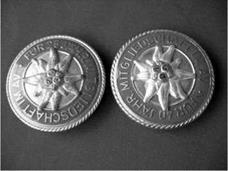Noble metals are also processed by the jewelry industry. In former times, these were soldered with each other, or one with the other, but entailing labor-intensive reworking to remove the flux residues or staining caused by elevated temperatures affecting the surface. Bonding is an attractive option that helps to save such costs (Figure 8.95).
On the reverse side of the tie-pin made from gilded brass (see Figure 8.95) the adhesive has escaped from the bond-line, whereas the bonding of a small elephant made from solid gold but affixed to a tie-pin made from sterling silver, is invisible, until it fails, for example ifthe tie-pin were to be dropped onto a brittle material such as glass or stone. The owner would be disappointed, not because ‘bonding is a cheap imitation, after all’, but because the jeweler used an adhesive that was not tolerated by the sensitive silver surface (tarnishing effect), or was too brittle.
It is advisable, however, not to bond decorative objects in the way that the medals shown in Figure 8.96 were bonded. The adhesive residue between the golden center plate and edelweiss and between the edelweiss and base plate, respectively, has spoiled 25 years of membership (left) compared to the reward for 40 years of paid membership (right).
|
Figure 8.96 Bonded medals. |
364 I 8 Adhesive Bonding Technology: Fields of Application
 23 января, 2016
23 января, 2016  Pokraskin
Pokraskin 
 Опубликовано в рубрике
Опубликовано в рубрике 